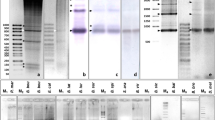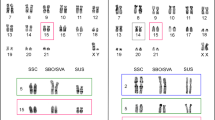Abstract
Two families of tandemly repeated satellite DNAs were isolated from the neotropical primate Callimico goeldii (Goeldi's marmoset). One satellite, CgoA, is over 70% A+T and has a monomer length of 338 bp. The other satellite, CgoB, is 50% A+T and has a monomer length of 916 bp. Both CgoA and CgoB hybridize strongly with Callimico DNA, but not with the DNA of other new and old world primates. Based upon a neutral substitution rate of 1.5×10−9/site per year for primates, sequence data from 15 CgoA monomers indicate that the tandem array is at least 30 million years old. Since no other neotropical primate has amplified CgoA sequences, the data suggest that the ancestor of Callimico separated from the other neotropical primates at least 30 million years ago. This value is about fourfold larger than the value of 7–9 million years derived from immunological data by Sarich and Cronin (1980). Possible reasons for this discrepancy are discussed.
Similar content being viewed by others
References
Bird AP (1986) CpG islands and the function of DNA methylation. Nature 321:209–213
Britten RJ (1986) Rates of DNA sequence evolution differ between taxonomic groups. Science 231:1393–1398
Bulmer M (1986) Neighboring base effects on substitution rates in pseudogenes. Mol Biol Evol 3:322–329
Daniels GR, Deininger PL (1985) Repeat sequence families derived from mammalian tRNA genes. Nature 317:819–822
Fanning TG (1987) Origin and evolution of a major feline satellite DNA. J Mol Biol 197:627–634
Fanning TG (1989) Molecular evolution of centromere-associated DNA sequences in two species of canids. Gene (in press)
Fanning TG, Modi WS, Wayne RK, O'Brien SJ (1988) Evolution of heterochromatin-associated satellite DNA loci in felids and canids (Carnivora). Cytogenet Cell Genet 48:214–219
Fleagle JG (1988) Primate adaptation and evolution. Academic Press, San Diego, Calif
Ford SM (1986) Systematics of the new world monkeys. In: Swindler DR, Erwin J (eds) Comparative primate biology, vol 1: Systematics, evolution, and anatomy. Alan R. Liss, New York, NY, pp 73–135
Hershkovitz P (1977) Living new world monkeys (Platyrrhini) with an introduction to the primates, vol. 1. Univ. Chicago Press, Chicago, Ill
Jeffreys AJ, Wilson V, Thein SL (1985) Hypervariable ‘minisatellite’ regions in human DNA. Nature 314:67–73
Li W-H (1983) Evolution of duplicate genes and pseudogenes. In: Nei M, Koehn RK (eds) Evolution of genes and proteins. Sinauer Assoc., Sunderland, Mass, pp 14–37
Maeda N, Wu C-I, Bliska J, Reneke J (1988) Molecular evolution of intergenic DNA in higher primates: pattern of DNA changes, molecular clock, and evolution of repetitive sequences. Mol Biol Evol 5:1–20
Maniatis T, Fritsch EF, Sambrook J (1982) Molecular cloning. A laboratory manual. Cold Spring Harbor, New York, NY
Miklos GLG (1985) Localized highly repetitive DNA sequences in vertebrate and invertebrate genomes. In: MacIntyre RJ (ed) Molecular evolutionary genetics. Plenum Press, New York, NY, pp 241–321
Modi WS, Fanning TG, Wayne RK, O'Brien SJ (1988) Chromosomal localization of satellite DNA sequences among twenty-two species of felids and canids (Carnivora). Cytogenet Cell Genet 48:208–213
Rosenberger AL (1981) Systematics: the higher taxa. In: Coimbra-Filho AF, Mittermeier RA (eds) Ecology and behaviour of neotropical primates. Academia Brasiliera de Ciencias, Rio de Janeiro, Brazil, pp 9–27
Sanger F, Nicklen S, Coulson AR (1977) DNA sequencing with chain terminating inhibitors. Proc Natl Acad Sci USA 74:5463–5467
Sarich VM, Cronin JE (1980) South American mammal molecular systematics, evolutionary clocks, and continental drift. In: Ciochon RL, Chiarelli AB (eds) Evolutionary biology of the new world monkeys and continental drift. Plenum Press, New York, NY, pp 399–421
Seuánez HN, Forman L, Matayoshi T, Fanning TG (1989) The Callimico goeldii (Primates, Platyrrhini) genome: Karyology and middle respectitive (LINE-1) DNA sequences. Chromosoma 98:389–395
Singer MF (1982) Highly repeated sequences in mammalian genomes. Int Rev Cytol 76:67–112
Szalay FS, Delson E (1979) Evolutionary history of the primates. Academic Press, New, NY
Author information
Authors and Affiliations
Additional information
On leave from: Genetics Section, Instituto Nacional do Cancer, Rio de Janeiro/Department of Genetics, Universidade Federal do Rio de Janeiro, Brazil
Rights and permissions
About this article
Cite this article
Fanning, T.G., Seuánez, H.N. & Forman, L. Satellite DNA sequences in the neotropical marmoset Callimico goeldii (Primates, Platyrrhini). Chromosoma 98, 396–401 (1989). https://doi.org/10.1007/BF00292784
Received:
Revised:
Issue Date:
DOI: https://doi.org/10.1007/BF00292784




